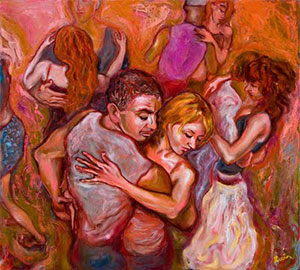
Merengue music, Merengue Tipico and Panbiche:
Merengue is a musical genre native to the Dominican Republic. Swift beats from güira or maracas percussion sections, and drums such as the tambora. The accordion is also common, Republic on the island of Hispaniola, most notably that of Haitian méringue and that of Haiti's national music compas. Traditional, acoustic merengue is best-represented by the earliest recorded musicians, like Angel Viloria and Francisco Ulloa. More modern merengue incorporate electric instruments and influences from salsa, and rock and roll. Merengue continued to be limited in popularity to the lower-classes, especially in the Cibao area, in the early 20th century. Artists like Juan F. García, Juan Espínola and Julio Alberto Hernández tried to move merengue into the mainstream, but failed, largely due to risque lyrics. Some success occurred after the original form (then called merengue típico cibaeño) was slowed down to accommodate American soldiers (who occupied the country from 1916–1924) and couldn't dance the difficult steps of the merengue; this mid-tempo version was called pambiche. Major mainstream acceptance started with the rise of Rafael Trujilloin the early 1930s.
Rafael Trujillo, who seized the presidency of the Dominican Republic in 1930, helped merengue to become a national symbol of the island up until his assassination in 1961. Being that he was of humble origins, he had been barred from elite social clubs. He therefore resented these elite sophisticates and began promoting the Cibao-style merengue as the populist symbol. The text of merengue songs covers an array of topics, including politics. This is evidenced by the hundreds of songs that were made, which were focused on political aspects of Trujillo's dictatorship, praising certain guidelines and actions of his party. Trujillo even made it mandatory for urban dance bands to include merengue in their routines. Also, piano and brass instruments were added in large merengue orchestras. On the other hand, merengue that continued to use an accordion became known as perico ripiao (ripped parrot). It was because of all this that merengue became and still is the Dominican Republic’s national music and dance.
Bachata:
Bachata is a style of music that inhabitants of shantytowns call their own to own. Though this may seem like almost a negative connotation, one should remember that bachata has been widely accepted by many, though not all, classes of Dominican society. Bachata evolved from bolero, a Pan-American style said to have originated in Cuba. The guitars (lead, rhythm, and bass) are the principal instruments in bachata. They are accompanied by the bongo and guira (which has replaced the maracas).
The Dominican bourgeoisie at first dismissed bachata as worthless and it was therefore given the name bachata, meaning a rowdy lower-class fiesta (party). Until fairly recently, bachata was informally banned from Dominican radio and television. Despite this, bachata flourished and has now gained wide acceptance, not only in the Dominican Republic, but world-wide.



